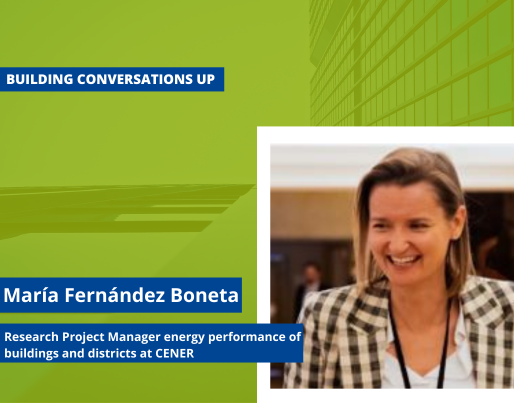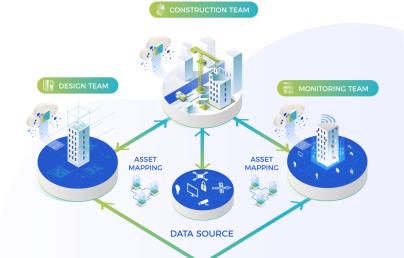María Fernández Boneta: 'The SRI will empower end users with information about the smart readiness of their buildings, including the ability to develop a self-assessment'

María Fernández Boneta: 'The SRI will empower end users with information about the smart readiness of their buildings, including the ability to develop a self-assessment'
Introduction
Senior Energy Efficiency Engineer with more than 15 years of experience in the areas of Energy Performance of Buildings, Energy Management Systems and integration of Renewable Energy Sources into buildings and districts. Certified Energy Manager (CEM) and Certified Measurement & Verification Professional (CMVP) by the AEE (Association of Energy Engineers) and KNX Partner and Tutor by KNX Association.
María currently works for CENER (the National Renewable Energy Centre of Spain), in the Energy Transition in Cities Department, where her work is being mainly focused on research and management of projects related to energy efficiency, energy transition, smart buildings, energy renovation of the building sector, energy performance assessment and certification, integration of renewable energy sources in buildings and districts, and zero carbon urban developments.
Since 2005 she has worked in several engineering companies, developing work as an energy efficiency consultant for new projects as well as for renovation projects and energy audits, including the design and installation of HVAC systems. The use and development of advanced computational methods for building energy modelling has also been an important part of her work, enabling the quantification of energy savings, the design of buildings to optimize energy performance, and the support of policies and roadmaps at national and European level to meet decarbonisation targets.
BUILD UP (BUP): What is the Smart Readiness Indicator (SRI) and what purpose does it serve in the context of smart technologies for buildings?
MARIA FERNANDEZ BONETA (MFB): The SRI is a common European scheme to assess the level of preparation of buildings to be smart, by means of the presence of building automation and control systems (BACS) to be able to optimize energy performance, provide comfort to occupants and be able to interact with the grid for instance through an active demand management. This instrument was already included in the 2018 revision of the EPBD and formally established later in 2020 through delegated and implementing regulations.
Its implementation at Member State and European level will give us a picture of the current state of the building stock in terms of its smartness and readiness to interact with building occupants and grids, as well as the use of smart technologies for effective energy management of buildings. Aggregated results after implementation in a representative sample of buildings will provide policy makers with the knowledge to implement roadmaps to progressively improve buildings smartness in order to be ready for the energy transition scenario, where a higher contribution of intermittent renewable sources to the electricity market implies the need for a flexible building stock able to contribute to the system balance.
From a technician’s point of view, this methodology can be a powerful tool to recommend improvement measures regarding BACS, which can provide cost-effective solutions to improve energy efficiency, but also to prepare buildings for the future energy transition scenario, at the same time improving the comfort and well-being of the building’s occupants. At the same time, the SRI will empower end users (i.e. building owners, tenants and occupants) with information about the smart readiness of their buildings, including the ability to develop a self-assessment.
BUP: How does the SRI assess the integration of various smart technologies within a building, such as IoT devices, sensors, and automation systems?
MFB: The SRI scheme incorporates a calculation framework defined in the SRI delegated Regulation, which includes the assessment of smart technologies present in a building, classified into nine technical domains: heating, cooling, domestic hot water, ventilation, lighting, dynamic building envelope, electricity, electric vehicle charging, and monitoring and control. Each service (e.g., heating emission) is rated according to its ability to impact on seven different impact criteria: energy efficiency, maintenance and fault prediction, comfort, convenience, health, wellbeing and accessibility, occupant information, and energy flexibility and storage.
Each service included in a National Service Catalogue (i.e., at Member State level) contains a list of functionality levels, from least to most smart, to cover the associated service. Each functionality level is described as an individual functionality, which in practice is associated with a physical installation that may include sensors, actuators, other control hardware, software and visual interfaces.
Finally, the calculation framework includes the weighted sum of all scores to provide a final SRI score, as well as aggregated scores per impact, domain and key functionality.
The SRI is based on a self-referencing system, which means that the indicator expressed as a percentage (%) is the score relative to the same building with the highest possible score.
"The SRI scheme incorporates a calculation framework defined in the SRI delegated Regulation, which includes the assessment of smart technologies present in a building, classified into nine technical domains"
BUP: The LIFE project SRI2MARKET will support the introduction of the SRI into the national regulations and markets of six EU countries. What barriers might be faced and how would the project aim to address them?
MFB: Yes, some of the current challenges that we face when we want to roll out SRI across the European Union could be for instance a lack of knowledge about the instrument in the market, potential complexity of implementation at National level and other technical challenges, e.g. to translate the SRI assessment into more quantitative information along the three main smart readiness impact areas (energy efficiency, energy flexibility and, where possible, comfort and well-being), or to investigate potential links with other relevant instruments such as energy performance certification.
To overcome these challenges, the SRI2MARKET project includes the development of the necessary tools to provide training and assessment tools for EPC assessors to become SRI experts. These tools and platforms will be available in seven official EU languages to facilitate their dissemination.
The project also includes a consistent stakeholder engagement strategy to be implemented in the six project countries, with the aim of involving key market actors such as policy makers, smart device manufacturers, market operators and EPB experts. Furthermore, SRI2MARKET is working together with other LIFE CET projects (i.e. easySRI, Smart2 and SRI-Enact) in a clustering initiative supervised by DG ENER and CINEA to effectively support the Member States' testing phases and the uptake of SRI.
BUP: The project has also developed an SRI2MARKET assessment tool. Can you explain its purpose and functionalities?
MFB: Yes, our assessment tool is available at https://sri2market.eu and is accessible after login. The main purpose of this web-based assessment tool is to provide a user-friendly experience for SRI assessors, enabling them to develop SRI assessments with optimal use of effort and resources.
In addition to being user-friendly for SRI assessors, the tool is also user-friendly for administrators through an administrative interface that allows customisation at Member State level (e.g., service catalogue, weighting factors, etc.) without the need for reprogramming. This can facilitate its adaptation to the particulate matter in each Member State.
The tool is now operational in seven languages, including the automatic generation of individual and aggregated SRI results from the case studies stored in its database (e.g., statistical values and histograms). Automatic recommendations will be incorporated throughout the life of the project.
BUP: What efforts are in place to raise public awareness about the SRI and its importance in promoting smart buildings?
MFB: According to Article 8 of the Implementing Regulation (2020), "Member States may undertake a non-committal test phase of the Smart Readiness Indicator scheme at national level". So far, eight official test phases have been launched, including Austria, Croatia, the Czech Republic, Denmark, Finland, France, Slovenia and Spain. The test phases cover different levels of scope, but in general most of them cover the capacity of the SRI assessors to assess a sample of real buildings under real conditions in order to draw conclusions on the procedure, methodology and implementation of the policy instrument at national level.
This is also well supported by the LIFE-CET SRI cluster (i.e. EasySRI, SRI-Enact, SRI2MARKET and Smart2 projects), which covers a total of 16 countries and provides support in terms of best practice recommendations, development of digital tools with smart features (e.g. automatic recommendations), calculation frameworks and market uptake, including training and demonstration.
In fact, the official Spanish test phase is largely based on the SRI2MARKET project and is technically supported by CENER. The scope of the Spanish test phase includes the evaluation of the whole chain for implementation; training needs, training programmes, web-based assessment tools, standard calculation framework, actual case studies, results and conclusions in order to obtain a clear roadmap for actual implementation when needed.


